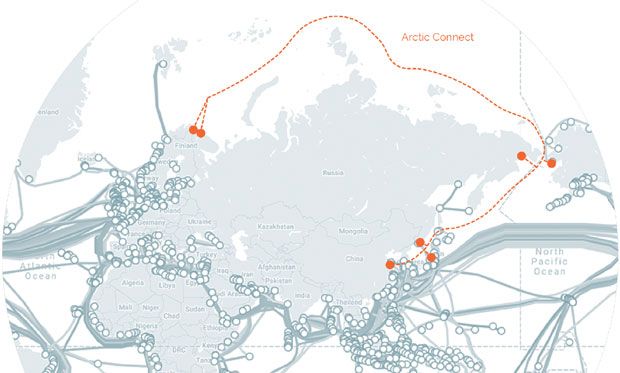Melting Arctic Ice Opens a New Fiber Optic Cable Route
Cinia and MegaFon’s proposed Arctic cable would bring lower latencies and geographical diversity
The most reliable way to reduce latency is to make sure your signal travels over the shortest physical distance possible. Nowhere is that more evident than the fiber optic cables that cross oceans to connect continents. There will always be latency between Europe and North America, for example, but where you lay the cable connecting the two continents affects that latency a great deal.
To that end, Helsinki-based Cinia, which owns and operates about 15,000 kilometers of fiber optic cable, and MegaFon, a Russian telecommunications operator, signed a memorandum of understanding to lay a fiber optic cable across the Arctic Ocean. The cable, if built, would not only reduce latency between users in Europe, Asia, and North America, but provide some much-needed geographical diversity to the world’s undersea cable infrastructure.
The vast majority of undersea cable encircles the world along a relatively similar path: From the east coast of the United States, cables stretch across the northern Atlantic to Europe, through the Mediterranean and Red Seas, across the Indian Ocean before swinging up through the South China Sea and finally spanning the Pacific to arrive at the west coast of the U.S. Other cable routes exist, but none have anywhere near the data throughput that this world-girding trunk line has.
Ari-Jussi Knaapila, the CEO of Cinia, estimates that the planned Arctic cable, which would stretch from London to Alaska, would shorten the physical cable distance between Europe and the western coast of North America by 20 to 30 percent. Additional cable will extend the route down to China and Japan, for a planned total of 10,000 kilometers of new cable.
Knaapila also says that the cable is an important effort to increase geographic diversity of the undersea infrastructure. Because many cables run along the same route, various events—earthquakes, tsunamis, seabed landslides, or even an emergency anchoring by a ship—can damage several cables at once. On December 19, 2008, 14 countries lost their connections to the Internet after ship anchors cut five major undersea cables in the Mediterranean Sea and Red Sea.
“Submarine cables are much more reliable than terrestrial cables with the same length,” Knaapila says. “But when a fault occurs in the submarine cable, the repair time is much longer.” The best way to avoid data crunches when a cable is damaged is to already have cables elsewhere that were unaffected by whatever event broke the original cable in the first place.
Stringing a cable across the Arctic Ocean is not a new idea, though other proposed projects, including the semi-built Arctic Fibre project, have never been completed. In the past, the navigational season in the Arctic was too short to easily build undersea cables. Now, melting sea ice due to climate change is expanding that window and making it more feasible (The shipping industry is coming to similar realizations as new routes open up).
The first step for the firms under the memorandum of understanding is to establish a company by the end of the year tasked with the development of the cable. Then come route surveys of the seabed, construction permits (for both on-shore and off-shore components), and finally, the laying of the cable. According to Knaapila, 700 million euros have been budgeted for investment in the route.
The technical specifics of the cable itself have yet to be determined. Most fiber optic cables use wavelengths of light around 850, 1300, or 1550 nanometers, but for now, the goal is to remain as flexible as possible. For the same reason, the data throughput of the proposed cable remains undecided.
Of course, not all cable projects succeed. The South Atlantic Express (SAex), would be one of the first direct links between Africa and South America, and connect remote islands like St. Helena along the way. But SAex has struggled with funding and currently sits in limbo. Cinia and MegaFon hope to avoid a similar fate.
Michael Koziol is an associate editor at IEEE Spectrum where he covers everything telecommunications. He graduated from Seattle University with bachelor's degrees in English and physics, and earned his master's degree in science journalism from New York University.
